|
Posted on 06/10/2003 4:43:29 AM PDT by snippy_about_it
|
|
 are acknowledged, affirmed and commemorated.
|

| Our Mission: The FReeper Foxhole is dedicated to Veterans of our Nation's military forces and to others who are affected in their relationships with Veterans. We hope to provide an ongoing source of information about issues and problems that are specific to Veterans and resources that are available to Veterans and their families. In the FReeper Foxhole, Veterans or their family members should feel free to address their specific circumstances or whatever issues concern them in an atmosphere of peace, understanding, brotherhood and support.
|
|
|
|
Korea June 10 - June 18, 1953 Outpost Harry was located in what was commonly referred to as the "Iron Triangle" in Korea. This was an area approximately 60 miles north of Seoul and was the most direct route to the South Korean capital. Outpost Harry's elevation was around 1280 feet high and positioned some 320 yards south of a larger landmass occupied by the CCF (Chinese Communist Forces) called "Star Hill" and some 425 yards northeast of United Nations positions. A service road that wound from the MLR (Main Line of Resistance) along an intermittent stream led to the rear of the outpost where a medical aid station and a supply point were located. The position contained a communication trench line which ran from the supply point forward some 400 yards to the top. At that point, the trench line joins another trench that makes a complete loop (circle) around the outpost with an additional finger that ran along the east ridge about 100 yards. The trench line was deep enough to walk around the perimeter unseen by the enemy. It was fortified with reinforced fighting bunkers, a command post and a forward observation bunker. It could accommodate approximately 150 infantrymen.  The outpost commanded an excellent view of the enemy positions as well as our own lines of defense. The elevation of the outpost was greater than any other friendly position within a mile. Since the Chinese did not have aerial observation, Outpost Harry was a strategic "military Hot Spot" and dearly desired by the Chinese. It's defense and preservation was viewed as critical because it blocked Chinese Communist Forces observation down the Kumwha Valley and shielded that portion of the MLR from enemy direct fire. If the UN forces lost the outpost, the U.S. Eighth Army would have had to withdraw approximately10 kilometers to the next defensible line, as shown in the photo at right. Furthermore, a CCF victory at Outpost Harry would have whet the appetite for more war and dishearten the American public to a point where it might accept an armistice term less favorable than was eventually was the case. During the period of June 1-8, 1953, aerial reconnaissance indicated that the enemy Chinese Communist Forces were building for a major offensive. The enemy units identified were the 22nd & 221st Regiments of the Chinese Communist 74th Division. King Company of the 15th. Infantry Regiment. was selected and ordered to occupy and defend Outpost Harry as they were considered a more experienced battle tested unit. It was a "Hold at all Costs" order with no withdrawal. With the background of "Peace Talks" on going, The CCF goal at this time was to inflect heavy casualties and to gain possible concessions at the truce table. King Company occupied Outpost Harry on the morning of June 6, 1953 through light enemy mortar fire. Upon reaching the summit and the outpost's fighting positions, King Company personnel along with the assistance of the 10th. Combat Engineers engaged in improving the fortifications. The trench line was deepened and expanded, bunkers reinforced, 55 gallons of napalm were installed and wired for firing, wire was strung, and communications improved. Meanwhile the company's defensive fire plan was developed and submitted to headquarters where the division artillery commander finally approved it.  On the evening of June 10th the Chinese launched their offensive by pounding the surrounding area and the outpost with artillery, mortar rounds and rocket fire. Around 2130 hours, and under the eerie glare of searchlights and parachute flares, the sudden blare of bugles and whistles signaled the enemy attack. Attacking in swarms, approximately 3600 enemy troops advanced forward throughout the night and the early hours of the next day. Despite an intense barrage of defensive firepower and the detonation of napalm, the invading CCF forces stormed the slopes of the outpost and soon penetrated the trenches. Over running the outpost they engaged King Company, 15th Infantry in hand to hand combat. The fighting became so intense that the Commanding Officer of King Company ordered his 39th Field Artillery Forward Observer to call in our artillery fire directly on the outpost. Fighting continued all night for possession of the outpost. In the early morning of June 11th advancing personnel of the 15th Infantry Easy and Charlie companies reinforced King Company to push the enemy forces back to their positions. Action like this continued. On the night of June 11th, Baker Company of the 15th and Baker Company of the 5th. RCT defended Harry. On the night of June 12th, Able Company of the 5th. RCT and Love Company of the 15th. Infantry Regiment defended Harry. They were supported by a detachment from the 10th. Combat. Engineer Battalion that got trapped on the outpost while on a mine laying detail. Charlie Company of the 5th. RCT took responsibility for Harry on June 13th and was replaced by companies P and N of the Greek Battalion. Finally, on June l8th the enemy forces called off their attack due to horrible loses inflected by the defending units.  George, Easy and Able Companies of the 15th Infantry as well as Dog Company of the 5th. RCT also participated in the defense. Other units supporting the action were the 65th. Infantry Regiment., the 10th Combat Engineer Battalion, the 10th, 39th, 58th, 555th, and 3rd AAA Artillery Units. Additionally, the 64th Heavy Tank Battalion, the 3rd Medical and the 3rd Signal Unit provided much needed resources for the defense of Harry. Units receiving the Distinguished Unit Citation for their performance on Harry were King Company, 15th. Infantry Regiment for the night of June 10/11, Baker Company, 15 Infantry for the night of June 11/12, Able Company, 5th. RCT for the night of June 12/13 and Peter Company, Greek Battalion for the night of June 17/18. In the annals of United States Infantry history it appears that this is the only time this many rifle companies received this distinguished award for an engagement of this type. Also recognized for valor and heroism was Sgt. Ola Mize, of King Co., 15th. Infantry Regiment. who was awarded the Congressional Medal of Honor for his actions of the night of June 10-11th, 1953. Some 39 years later, 11 veterans from around the country decided to hold a reunion in honor of the Outpost Harry Siege. That first reunion was held at Fort Stewart, Ga. It was decided at that time that it would be appropriate to meet yearly around the anniversary date of June 10th to commemorate those that defended and preserved the outpost and to those who made the ultimate sacrifice. Thus the Outpost Harry Survivors Association was established. 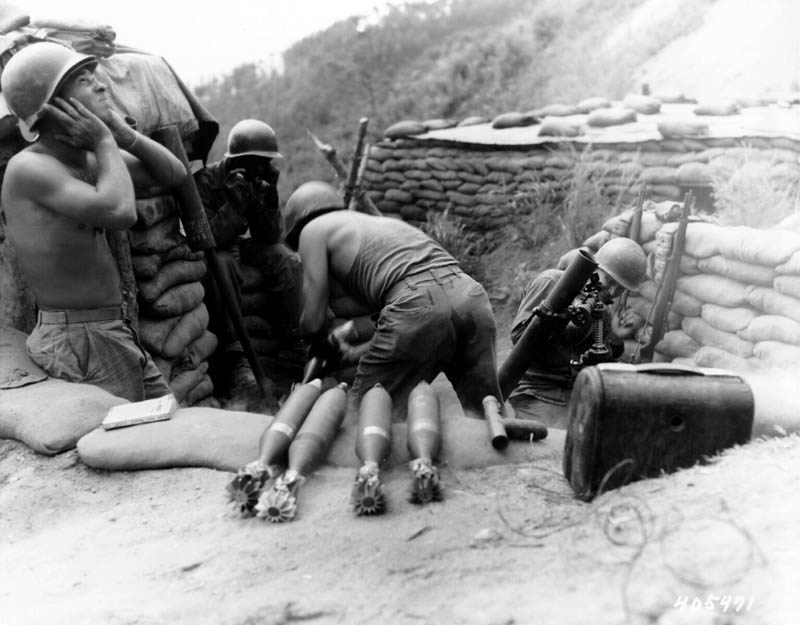 Since that first reunion meeting, The Outpost Harry Survivors Association has grown to over 160 members. At the reunion in 2001 it was decided that any veteran that defended Outpost Harry, regardless of time served, was to be considered a regular member of the Association. There was never a safe time to be on Outpost Harry. The Greeks had a name for it and it was called "Death Place". If you served on Harry, you knew that was true. We invite you to share our Outpost Harry web site in honor of all that served and put their lives on the line to preserve it against overwhelming enemy numbers. Out motto is, "WE HELD". And indeed we did!
|





I sure do miss you but I'm lovin' my gifts, look at all these flowers and it's only Tuesday night of week one!
(I know, don't remind you. lol.)
Your plan is working. Good night SAM

Annotated photograph of OP Harry taken from Artillery Observation Post Howe (Courtesy of James Jarboe)


MIZE, OLA LEE
Rank and organization: Master Sergeant (then Sgt.), U.S. Army, Company K, 15th Infantry Regiment, 3d Infantry Division. Place and date: Near Surang-ni, Korea, 10 to 11 June 1953. Entered service at: Gadsden, Ala. Born: 28 August 1931, Marshall County, Ala. G.O. No.: 70, 24 September 1954.
Citation:
M/Sgt. Mize, a member of Company K, distinguished himself by conspicuous gallantry and outstanding courage above and beyond the call of duty in action against the enemy. Company K was committed to the defense of "Outpost Harry", a strategically valuable position, when the enemy launched a heavy attack. Learning that a comrade on a friendly listening post had been wounded he moved through the intense barrage, accompanied by a medical aid man, and rescued the wounded soldier. On returning to the main position he established an effective defense system and inflicted heavy casualties against attacks from determined enemy assault forces which had penetrated into trenches within the outpost area. During his fearless actions he was blown down by artillery and grenade blasts 3 times but each time he dauntlessly returned to his position, tenaciously fighting and successfully repelling hostile attacks. When enemy onslaughts ceased he took his few men and moved from bunker to bunker, firing through apertures and throwing grenades at the foe, neutralizing their positions. When an enemy soldier stepped out behind a comrade, prepared to fire, M/Sgt. Mize killed him, saving the life of his fellow soldier. After rejoining the platoon, moving from man to man, distributing ammunition, and shouting words of encouragement he observed a friendly machinegun position overrun. He immediately fought his way to the position, killing 10 of the enemy and dispersing the remainder. Fighting back to the command post, and finding several friendly wounded there, he took a position to protect them. Later, securing a radio, he directed friendly artillery fire upon the attacking enemy's routes of approach. At dawn he helped regroup for a counterattack which successfully drove the enemy from the outpost. M/Sgt. Mize's valorous conduct and unflinching courage reflect lasting glory upon himself and uphold the noble traditions of the military service.

This panorama was made from two pictures from Bob Brandon who was on OP Harry in March of '53. He made the shots from the left forward flank of the OP. The view is directly North from that vantage point and shows Star against the sky about 1/3 of the way in from the left margin. The darker ridge leading from Star to the barbed wire below the excavation at the right was one of the routes of approach to the OP for the CCF. A CCF trench can be seen at right center. (Photos courtesy of Bob Brandon as stitched by James Jarboe)
Korea - Photos by James Jarboe
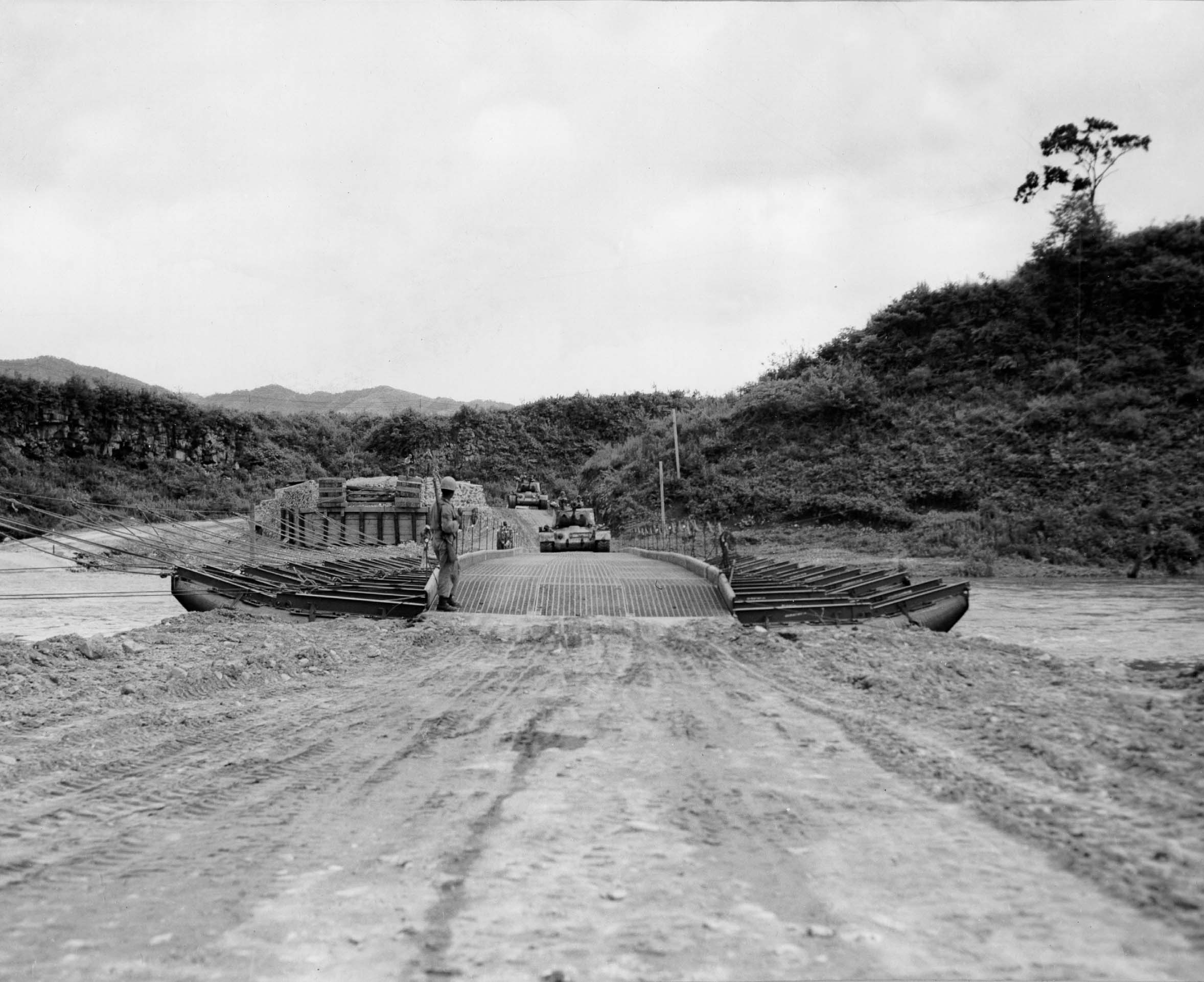
ES42-5-209 (SC434176) Tanks of Co "B", 64th Tank Bn, (90-mm gun), 3rd U.S. In Div, start across newly constructed floating bridge across the flooded Han Tan River. 10 Jul 1953.

M-41 self-propelled 155mm howitzer

Gun crew of a 105mm howitzer in action along the 1st Cavalry Division sector of the Korean battle front.

The MK-II A1 hand grenade commonly used by US forces was of the Defensive (fragmentation) type. This grenade functions on the same principle as all other US grenades by priming the detonator, by releasing the safety catch. The body of the grenade is made of cast iron in a checkered pattern.
The firing system is composed of the safety catch, handle (spoon), the firing pin and the detonator, screwed on the grenade’s top. The safety pin holds the lever down, which in turn stops the striker from hitting the primer. To arm the grenade, the pin must first be removed and the handle held down. On releasing the grenade from the hand, the handle (or spoon) will fly off and a striker will fly down and strike the fuse. Because of its sectional casing, on exploding, the fragments will fly out and vary in shape and size.
Early grenade models were painted yellow but this made them too much of a target, and around late 1942 to early 1943 they were painted olive-drab, with a yellow ring painted on the body next to the fuse.
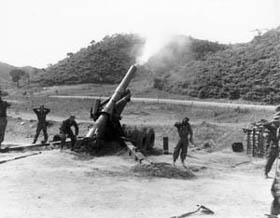
SC400100 - KOREAN CONFLICT
An 8-inch howitzer is fired by members of Battery A, 17th FA Bn., 45th U.S. Inf. Div., north of Yonchon, Korea. 27 May 1952. Korea.
Signal Corps Photo #10-340-2/FEC-52-14563 (Kassal)
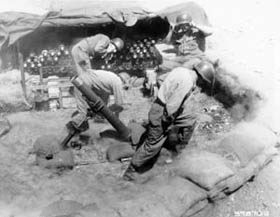
SC398703 - A 4.2-inch mortar crew of the Heavy Mortar Company, 179th Regiment, 45th U.S. Infantry Division, fires on Communist positions, west of Chorwon, Korea. 5 May 1952. Korea.
Signal Corps Photo #10-296-1/FEC-52-13339 (Kassal)

Heads up Charlie!

Home
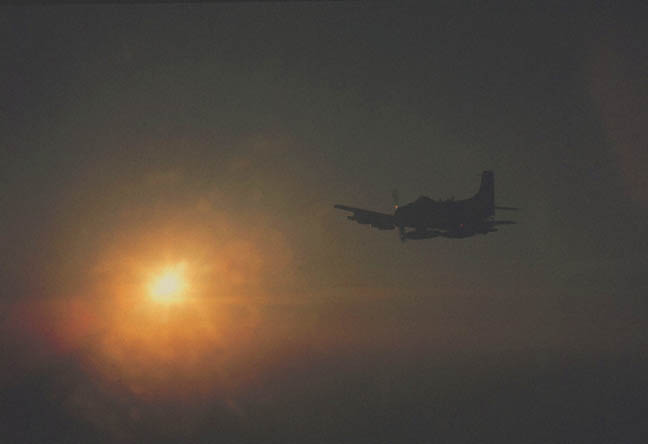
|
Disclaimer: Opinions posted on Free Republic are those of the individual posters and do not necessarily represent the opinion of Free Republic or its management. All materials posted herein are protected by copyright law and the exemption for fair use of copyrighted works.